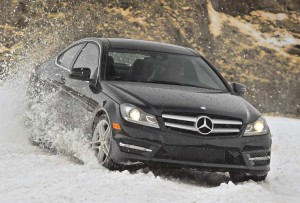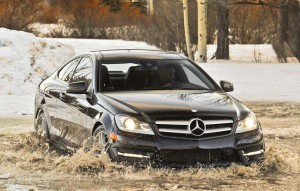Mercedes-Benz proudly claims to building the industry’s very first all-wheel-drive vehicle almost 100 years ago, a giant touring car used for hunting parties in Africa.
It started building four-wheel-drive systems for modern passenger cars in 1985, and has used the 4MATIC moniker on each succeeding generation.
Until recently, a luxury buyer looking for a Mercedes with traction going to all four wheels had a fairly limited option set. But that’s about to change – the German maker soon to make an all-new version of the technology available on 21 of its different products.
The smaller, lighter, more compact fourth-generation 4MATIC system will debut shortly in the S 350 BlueTec diesel sedan ($93,425), the CLS 550 four-door coupe ($74,675), the new E 350 coupe ($53,175), and the new C 350 coupe ($45,245), adding about $2000 to the price of the rear-drive versions of each model.
The new system is fully 50% lighter than the original, part-time 4MATIC system, down from 300 pounds to 150 pounds, and Mercedes-Benz says that, depending on model, the added weight of the system compared to rear-drive versions is either a zero highway mileage penalty or only one mpg highway.
The new 4Matic system is set to send 45% of engine torque to the front tires and 55% to the rear tires under normal driving conditions, and can vary the torque split from 30/70 front-to-rear to 70/30 when available traction dictates.
The new 4MATIC system is housed completely within the case of the 7-speed automatic transmission and is made entirely in-house by Mercedes-Benz, as is the transmission.
Previous versions used an external three-gear transfer case to send power to the front axle, in a housing that protruded from the right side of the transmission, with an external universal joint in the shaft going to the front axle.
The new system, mounted inside the transmission, uses only two gears, making it much narrower, and the universal joint is housed inside the transmission case. Where all previous generations required 4MATIC-equipped cars to have a completely different front floor pan to accommodate the wide transfer case, from now on, the rear-drive and 4MATIC versions of each model will have the same floorpan.
To make the system work properly with only the two gears, the ring-and-pinion gears in the front axle have been turned upside down from their previous orientation.
TheDetroitBureau.com spent a day last week driving all the new models on a highway loop on snow-covered roads in Wyoming and Idaho, on an off-road snow and ice course, and on an icy drag strip, and the new system performed flawlessly, with a variety of Continental, Michelin and Pirelli winter tires mounted on their alloy wheels.
As before, the mechanical system works in concert continuously with the ABS brakes, ETS traction control system and the ESP yaw control system to keep the car on its intended path.
In our test drive, the overall handling and ride advantage went to the heavier CLS 550 and S 350 diesel models, and the best overall performance came from the S 350 diesel, which has a more compliant and comfortable air suspension that the C, E, and CLS versions do not offer.
Mercedes-Benz says that it has sold more than a million vehicles in the U.S. with the various 4MATIC systems since 1989, and that the new system is the lightest and one of the quietest and most efficient systems offered by any manufacturer.


